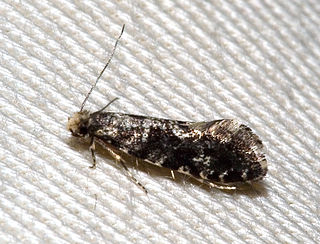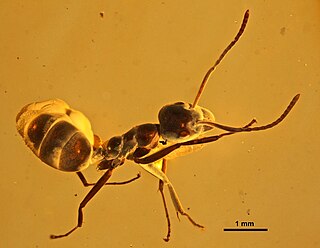
Pentatomidae is a family of insects belonging to the order Hemiptera, generally called shield bugs or stink bugs. Pentatomidae is the largest family in the superfamily Pentatomoidea, and contains around 900 genera and over 4700 species. As hemipterans, the pentatomids have piercing sucking mouthparts, and most are phytophagous, including several species which are severe pests on agricultural crops. However, some species, particularly in the subfamily Asopinae, are predatory and may be considered beneficial.

Tineidae is a family of moths in the order Lepidoptera described by Pierre André Latreille in 1810. Collectively, they are known as fungus moths or tineid moths. The family contains considerably more than 3,000 species in more than 300 genera. Most of the tineid moths are small or medium-sized, with wings held roofwise over the body when at rest. They are particularly common in the Palaearctic, but many occur elsewhere, and some are found very widely as introduced species.

Anthocoridae is a family of bugs, commonly called minute pirate bugs or flower bugs. Worldwide there are 500-600 species.

Alydidae, commonly known as broad-headed bugs, is a family of true bugs very similar to the closely related Coreidae. There are at least 60 genera and 300 species altogether. Distributed in the temperate and warmer regions of the Earth, most are tropical and subtropical animals; for example Europe has a mere 10 species, and only 2 of these occur outside the Mediterranean region.

Dictyopharidae is a family of planthoppers, related to the Fulgoridae. The family comprises nearly 760 species in more than 150 genera which are grouped into two subfamilies, Dictyopharinae and Orgeriinae.

Liorhyssus hyalinus is a species of scentless plant bugs belonging to the family Rhopalidae, subfamily Rhopalinae.
Oncotylus setulosus is a species of plant bugs belonging to the family Miridae, subfamily Phylinae. It is found in Austria, Bulgaria, Czech Republic, France, Germany, Hungary, Moldova, Romania, Slovakia, Spain, Ukraine, and all states of former Yugoslavia.
Pristomyrmex rasnitsyni is an extinct species of ant in the genus Pristomyrmex. The species is known from a single Late Eocene fossil which was found in Europe.

Tytthus is a genus of insects in family Miridae, the plant bugs. They are carnivorous, feeding upon the eggs of various planthoppers in the family Delphacidae, and thus are important in the biological control of pests. The genus is distributed throughout the Holarctic of the Northern Hemisphere, but species are also found in the tropics, in China, South America, Australia, and the Indo-Pacific.

Cryptostemma is a genus of bugs in the family Dipsocoridae, first described by Herrich-Schäffer in 1835. The species Cryptostemma alienum is recorded from northern Europe including the British Isles.

Usomyrma is an extinct genus of ant in the formicid subfamily Dolichoderinae. The genus contains a single described species, Usomyrma mirabilis, that is known from two Middle Eocene fossils which were found in Scandinavian amber in Denmark.

Yantaromyrmex is an extinct genus of ants first described in 2013. Members of this genus are in the subfamily Dolichoderinae of the family Formicidae, known from Middle Eocene to Early Oligocene fossils found in Europe. The genus currently contains five described species, Y. constrictus, Y. geinitzi, Y. intermedius, Y. mayrianum and Y. samlandicus. The first specimens were collected in 1868 and studied by Austrian entomologist Gustav Mayr, who originally placed the fossils in other ant genera until the fossils were reviewed and subsequently placed into their own genus. These ants are small, measuring from 4 to 6 mm in length and can be characterized by their trapezoidal shaped head-capsules and oval compound eyes that are located slightly to the rear of the capsules midpoint, with no known ocelli present.

Elephantomyia (Elephantomyia) baltica is an extinct species of crane fly in the family Limoniidae. The species is solely known from the Middle Eocene Baltic amber deposits in the Baltic Sea region of Europe. The species is one of six described from Baltic amber.

Elephantomyia (Elephantomyia) brevipalpa is an extinct species of crane fly in the family Limoniidae. The species is solely known from the Middle Eocene Baltic amber deposits in the Baltic Sea region of Europe. The species is one of six described from Baltic amber.
Leptopharsa tacanae is an extinct species of lace bug in the family Tingidae. The species is solely known from the Late Oligocene to Middle Miocene Mexican amber deposits. The species is the first lace bug described from Mexican amber.

Elephantomyia (Elephantomyia) longirostris is an extinct species of crane fly in the family Limoniidae. The species is solely known from the Middle Eocene Baltic amber deposits in the Baltic Sea region of Europe. The species is one of six in its genus described from Baltic amber.

Elephantomyia (Elephantomyia) pulchella is an extinct species of crane fly in the family Limoniidae. The species is solely known from the Middle Eocene Baltic amber deposits in the Baltic Sea region of Europe. The species is one of six described from Baltic amber.

Paraneuretus is an extinct genus of formicid in the ant subfamily Aneuretinae known from fossils found in Asia and Europe. The genus contains three middle to late Eocene age species, Paraneuretus dubovikoffi, Paraneuretus longicornis, and Paraneuretus tornquisti.
Pachycoleus is a genus of bugs in the family Dipsocoridae, erected by Franz Xaver Fieber in 1860. The type species Pachycoleus waltli is recorded from northern Europe including the British Isles.















